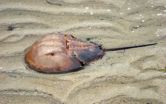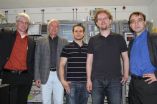(Press-News.org) Freelance writer Robert Brault offers a metaphor for the night sky, "A trillion asterisks and no explanations." By supporting astronomers, the National Science Foundation (NSF) helps to provide explanations. A recent NSF- and NASA-funded study provides one more explanation.
Astronomers have discovered a new population of Jupiter-size planets floating alone in the dark of space, away from the light of a star. According to the scientists, these lone worlds were probably ejected from developing planetary systems.
The discovery is based on a joint Japan-New Zealand survey, the Microlensing Observations in Astrophysics (MOA), that scans the center of our Milky Way galaxy every year. Using data collected between 2006 and 2007, these reseachers turned up evidence for what now appear to be 10 free-floating planets roughly the mass of Jupiter.
Sometimes called "orphan" planets, these isolated orbs have long been the subject of science theories and science fiction, but their existence remained uncertain until now.
The new findings not only demonstrate that free-floating planets are out there in space, but also suggest they are common. For every star in our galaxy, the research team says there are about two free-floating Jupiter-mass planets, and possibly even more Earth-mass ones though planets this small were not detected.
"There are hundreds of billions of stars in our galaxy," said David Bennett, a NSF- and NASA-funded co-author of the study from the University of Notre Dame in South Bend, Ind. "We think free-floating gas giant planets are at least as numerous as planets orbiting stars, and more common than stars. Our present survey is not sensitive to planets less massive than Jupiter and Saturn, but theories suggests that lower mass planets like Earth should be ejected from their stars more often and are thus more common."
Details of their findings appear in the May 19 issue of the journal Nature. The lead author is Takahiro Sumi, who is currently at Osaka University in Japan.
Previous observations have spotted free-floating planet-like objects within star-forming clusters, with masses low as roughly three times that of Jupiter. Scientists debate over whether these gaseous bodies form like stars or planets. Small, dim stars called brown dwarfs form like stars, growing from collapsing balls of gas and dust, but they lack the mass to ignite their nuclear fuel and shine with starlight. It's possible that brown dwarfs could be as small as planets.
It's also possible that planets get the "boot" from their early solar systems, a rambunctious time when growing planets can be ejected from their orbits due to close gravitational encounters with other planets or stars. Without a star to circle, these planets would move through the galaxy as our sun and others stars do, in stable orbits around the galaxy's center. The fact that the new survey found 10 free-floating Jupiters supports the "ejection" scenario, though it's possible that both mechanisms are at play.
"If free-floating planets formed like stars then we would have expected to see only 1 or 2 of them in our survey instead of 10," said Bennett. "The results suggest that planetary systems often become unstable, with planets being kicked out from their places of birth."
The survey--MOA--uses a 1.8-meter telescope at Mt. John University Observatory in New Zealand to regularly scan the copious stars at the center of our galaxy for what are called microlensing events.
These events occur when something, such as a star or planet, passes in front of another more distant star. The passing body's gravity warps the light of the background star, causing it to magnify and brighten.
Heftier passing bodies, such as massive stars, will warp the light of the background star to a greater extent, resulting in brightening events that can last weeks. Small planet-size bodies will cause less of a distortion, and brighten a star for only a few days or less.
The astronomy team found about 10 short microlensing events indicating free-floating planets of roughly Jupiter's mass. They said that they cannot rule out that some of these planets may be in very distant orbits about stars, but other research indicates that Jupiter-mass planets in such distant orbits are rare.
According to models of how common stars are in our galaxy, this new population of free-floating Jupiter-size planets outnumbers stars in our galaxy by nearly a factor of two. Likewise, the researchers say the free-floating planets may get kicked out of their solar systems at such high rates to be at least as common as planets like ours that orbit a star.
Based on these predictions, our galaxy may host hundreds of billions of the lone worlds. The new survey is like a population census--by sampling a portion of the galaxy, and knowing the constraints of the survey, researchers can estimate the prevalence of free-floating worlds.
A second microlensing survey group, the Optical Gravitational Lensing Experiment (OGLE) contributed to this discovery. The OGLE group also observed many of these same microlensing events, and their observations independently confirmed the analysis of the MOA group. The late Bohdan Paczynski was instrumental in instigating the highly cooperative nature of the gravitational microlensing field, by encouraging OGLE and the other groups to share their data as soon as soon as it is taken. This has been important for many microlensing discoveries, and is in part, why MOA contacted OGLE to confirm the results and to write up a joint paper.
INFORMATION:
Common Jupiters?
New research shows that free-floating Jupiters may be more common than stars
2011-05-23
ELSE PRESS RELEASES FROM THIS DATE:
Mount Sinai researchers discover possible new target for sarcoma treatment and prevention
2011-05-23
Researchers from Mount Sinai School of Medicine have discovered a protein signaling pathway that becomes hyperactivated in human sarcoma cells, suggesting that medications to inhibit this pathway may be effective in the treatment of human sarcomas. The research is published in the current issue of the journal Cancer Cell.
A team of researchers led by Stuart Aaronson, MD, Jack and Jane B. Aron Professor and Chairman of the Department of Oncological Sciences at Mount Sinai School of Medicine, compared normal human mesenchymal stem cells to human sarcoma cells and found ...
American Community Television Calls on AT&T to Make PEG Channels Available to the Blind and Vision Impaired Community
2011-05-23
American Community Television (ACT) sent letters last Thursday to Randall Stephenson, the President of AT&T, and to Jacquelyn Brand, the chair of the AT&T Advisory Panel on Access & Aging, asking that AT&T deliver Public, Educational and Government (PEG) access channels the same as all other channels on the U-Verse system.
"AT&T's U-Verse platform discriminates against persons who are blind or visually impaired," said John Rocco, President of ACT. "We cannot access PEG channels through the Channel 99 on-screen menu."
Mr. Rocco, ...
Replacing the blue bloods
2011-05-23
The Food and Drug Administration requires every drug they certify to be tested for certain poisons that damage patient health. The current gold standard for this is the limulus amoebocyte lysate (LAL) assay that involves using the blood of horseshoe crabs, which strangely enough is blue, to test for endotoxin, a substance commonly associated with many symptoms caused by bacterial infections.
But researchers at the Department of Chemical and Biological Engineering at the University of Wisconsin-Madison have found what may be a more effective way to test for endotoxin that ...
Novel man-made material could facilitate wireless power
2011-05-23
DURHAM, N.C. – Electrical engineers at Duke University have determined that unique man-made materials should theoretically make it possible to improve the power transfer to small devices, such as laptops or cell phones, or ultimately to larger ones, such as cars or elevators, without wires.
This advance is made possible by the recent ability to fabricate exotic composite materials known as metamaterials, which are not so much a single substance, but an entire man-made structure that can be engineered to exhibit properties not readily found in nature. In fact, the metamaterial ...
Whataburger Introduces New Honey Mustard Chicken Club Sandwich
2011-05-23
Just in time for summer, Whataburger today announced the Honey Mustard Chicken Club, its newest menu item available for a limited time only. The new chicken sandwich - with a choice of grilled or crispy chicken -- is available Monday, May 23 at 3 p.m. through Monday, June 27 at Whataburger's 700-plus locations across 10 states.
The made-to-order Honey Mustard Chicken Club sandwich features a choice of Grilled Chicken or Whatachick'n filet, freshly chopped lettuce, tomato, bacon, Swiss American cheese and Honey Mustard sauce on a wheat bun. It is the newest addition to ...
USDA/AIA survey reports 2010/2011 winter honey bee losses
2011-05-23
This release is available in Spanish.
WASHINGTON - Total losses from managed honey bee colonies nationwide were 30 percent from all causes for the 2010/2011 winter, according to the annual survey conducted by the U.S. Department of Agriculture (USDA) and the Apiary Inspectors of America (AIA).
This is roughly similar to total losses reported in similar surveys done in the four previous years: 34 percent for the 2009/2010 winter, 29 percent for 2008/2009; 36 percent for 2007/2008, and 32 percent for 2006/2007.
"The lack of increase in losses is marginally encouraging ...
World record in ultra-rapid data transmission
2011-05-23
This release is available in German.
Scientists of Karlsruhe Institute of Technology (KIT) have suc-ceeded in encoding data at a rate of 26 terabits per second on a single laser beam, transmitting them over a distance of 50 km, and decoding them successfully. This is the largest data volume ever transported on a laser beam. The process developed by KIT allows to transmit the contents of 700 DVDs in one second only. The renowned journal "Nature Photonics" reports about this success in its latest issue (DOI: 10.1038/NPHOTON.2011.74).
With this experiment, the KIT scientists ...
An electric motorcycle is created at Carlos III University of Madrid
2011-05-23
This release is available in Spanish.
This project, known as e-Moto, was created and developed by LGN Tech Design, a spin-off company that has its origins in a line of research begun in the Laboratorio de Máquinas (MAQLAB – Machine Laboratory) of UC3M and receives support from the University's Vice-Chancellor's Office of Research through the Business Incubator UC3M Science Park. "The technology that we have developed is a result of the design of a platform for the modeling, analysis and evolution of racing motorcycles, which was then applied to the development of the ...
Bruegger's Adds New Cafe Salad to Its Flavorful Lunch Menu
2011-05-23
Today Bruegger's announced the addition of a new line of "Cafe Salads" to its lunch menu. Part of its summer-long healthy menu initiative, the salads are available in five chef-created options at all of Bruegger's 300 plus bakeries.
According to the National Restaurant Association, nutrition and health continue to be in high demand from consumers, along with a focus on value. Bruegger's Cafe Salads meet this growing trend, offering guests fresh, great tasting options in a lunch portion size with fewer calories and all the taste. And, at just $4.99 (prices ...
Whites believe they are victims of racism more often than blacks
2011-05-23
MEDFORD/SOMERVILLE, Mass. -- Whites believe that they are replacing blacks as the primary victims of racial discrimination in contemporary America, according to a new study from researchers at Tufts University's School of Arts and Sciences and Harvard Business School. The findings, say the authors, show that America has not achieved the "post-racial" society that some predicted in the wake of Barack Obama's election.
Both whites and blacks agree that anti-black racism has decreased over the last 60 years, according to the study. However, whites believe that anti-white ...
LAST 30 PRESS RELEASES:
Chonnam National University researchers propose innovative voltage-loop control for power factor correction
Accelerating next-generation drug discovery with click-based construction of PROTACs
Detecting the hidden magnetism of altermagnets
$7M gift supports health research, engineering and athletics at UT San Antonio
NU-9 halts Alzheimer’s disease in animal model before symptoms begin
Hospitals acquired by real estate investment trusts associated with greater risk of bankruptcy, closure
City of Hope scientists study rare disorder to uncover mechanism and hormone regulation underlying fatty liver disease and sweet aversion
Your genes may influence gut microbiome of others, rat study shows
‘Personality test’ shows how AI chatbots mimic human traits – and how they can be manipulated
Global food systems driving twin crises of obesity and global heating
Osaka Medical and Pharmaceutical University researchers capture real-time molecular movies of enzyme catalysis
Could your genes influence the gut microbiome of others?
Clues to Alzheimer’s disease may be hiding in our ‘junk’ DNA
Study reveals that the body uses different sensors to detect cold in the skin and in internal organs
iPS cells from dish to freezer and back
Deep neural networks enable accurate pricing of American options under stochastic volatility
Collective risk resonance in Chinese stock sectors uncovered through higher-order network analysis
Does CPU impact systemic risk contributions of Chinese sectors? Evidence from mixed frequency methods with asymmetric tail long memory
General intelligence framework to predict virus adaptation based on a genome language model
Antibiotic resistance is ancient, ecological, and deeply connected to human activity, new review shows
Vapes, pouches, heated tobacco, shisha, cigarettes: nicotine in all forms is toxic to the heart and blood vessels
From powder to planet: University of Modena engineers forge a low-carbon future for advanced metal manufacturing
Super strain-resistant superconductors
Pre-school health programme does not improve children’s diet or physical activity, prompting call for policy changes, study finds
Autumn clock change linked to reduction in certain health conditions
AI images of doctors can exaggerate and reinforce existing stereotypes
Where medicine meets melody – how lullabies help babies and parents in intensive care
We may never be able to tell if AI becomes conscious, argues philosopher
AI video translation shows promise but humans still hold the edge
Deep ocean earthquakes drive Southern Ocean’s massive phytoplankton blooms, study finds
[Press-News.org] Common Jupiters?New research shows that free-floating Jupiters may be more common than stars







